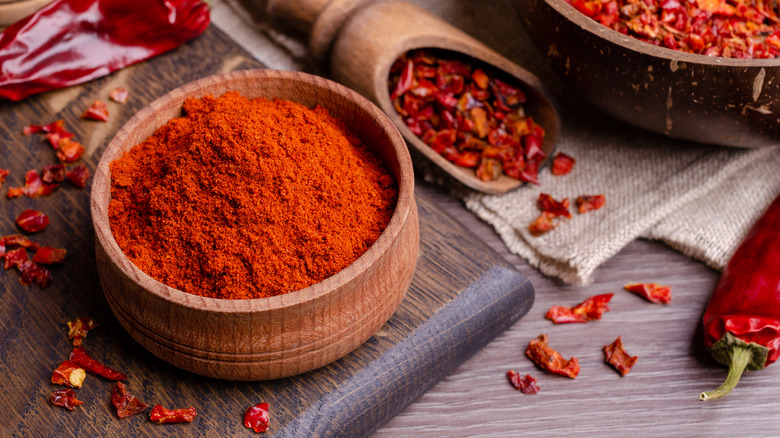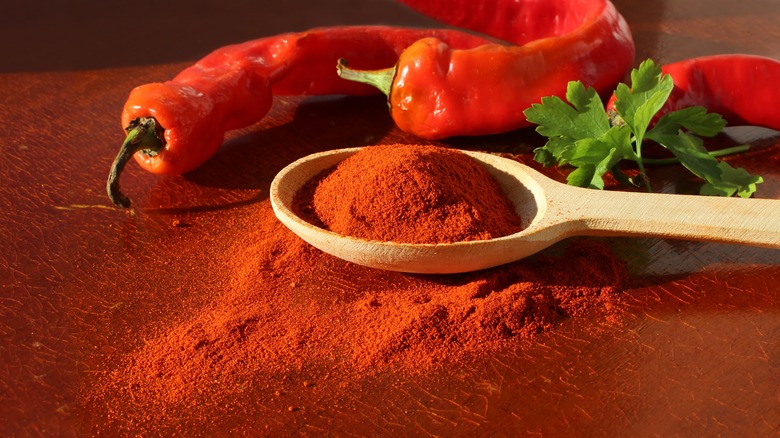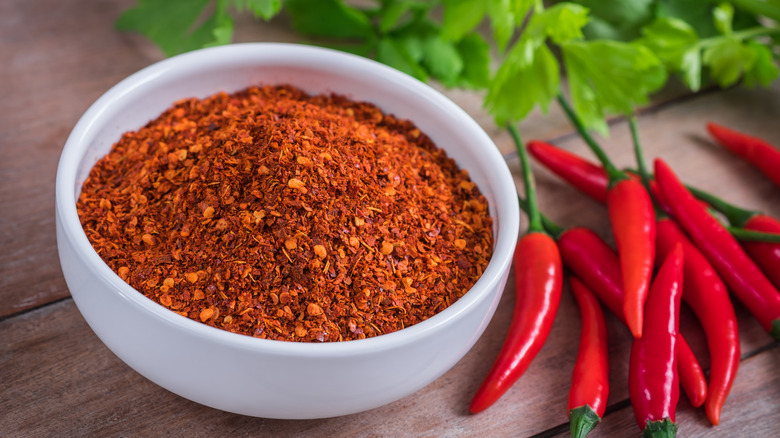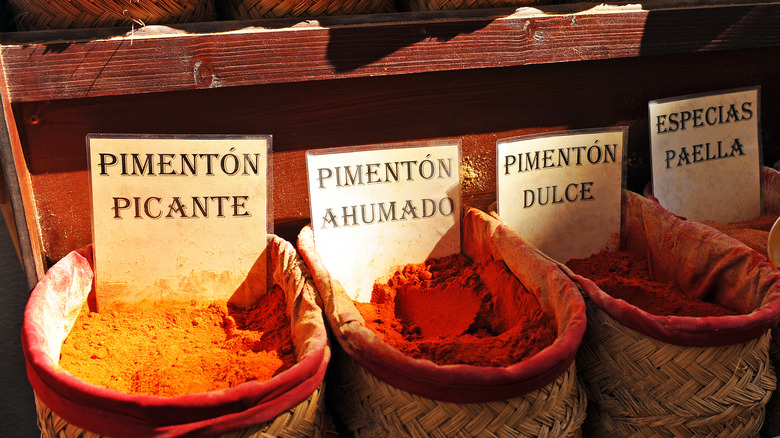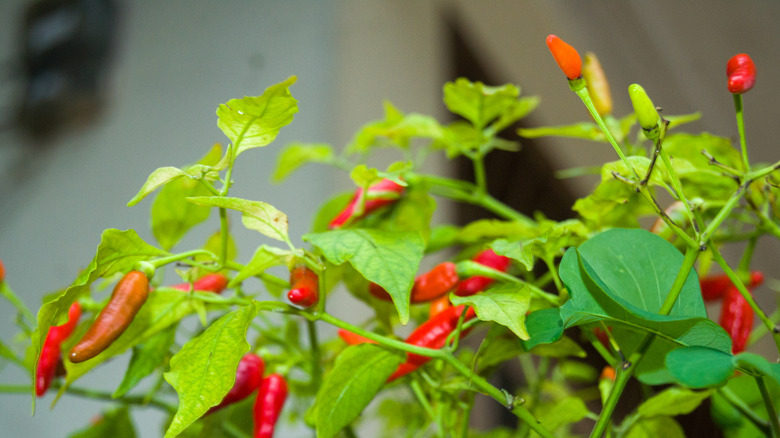Cayenne Pepper Vs Hot Paprika: What's The Difference?
When it comes to spices, names can start to run together — especially if, like with cayenne and paprika, they look pretty similar. Sometimes, it's difficult to know which to choose. Which spice should you pick if you want to add heat to a bowl of chili? Will cayenne overwhelm your deviled eggs?
Both cayenne and paprika are made from peppers from the species Capsicum annum. But paprika — even hot paprika — is generally milder, while cayenne has a strong, spicy taste and comes from one specific kind of pepper (the cayenne pepper).
Yep — that means that there's no one specific paprika pepper plant. The spice can be made from many different varieties, but it typically comes from plain old bell peppers. The same peppers that you roast, stuff, or turn into salads lend their flavor to the subtle spice. Hotter varieties of paprika can also include poblano peppers, aleppo peppers, or even cayenne peppers — the type used in ground cayenne. But when it comes to choosing either of these spices for a dish, when should you use them? A closer look at each one shows why you may not get the flavor you're expecting if you try to substitute one for the other.
What is hot paprika?
Ranging from sweet to savory, mild to slightly spicy, and orange to deep red in color, paprika is a varied spice with many uses. While most paprika doesn't pack the same punch as spices made from hotter peppers, it adds a complex, earthy flavor to stews, barbeque rubs, and more — famously garnishing deviled eggs and serving as the basis for dishes like chicken paprikash.
Hot paprika generally refers to paprika made from hot paprika peppers, a kind of chili grown in Eastern Europe. But despite their name, hot paprika peppers aren't actually that hot. Paprika made from these peppers generally tops out at around 590 Scoville heat units, rarely reaching 1,000 — which means that while it's more pungent than the regular stuff, it's still pretty mild in comparison to other popular spices. Hot paprika is sometimes even cut with cayenne to give it more of a kick.
The spicier varieties of paprika are a star ingredient in Hungarian cuisine. Goulash, one of the country's most famous dishes, features hot paprika prominently, as does the stuffed pepper dish töltött paprika. Hungarians have used paprika since the 1600s after the peppers made their way over from the Americas, but the spice found its home in Hungarian culture in 1879 after a flood destroyed the city of Szeged and paprika production bolstered the city's recovery. The spice became a source of national pride, especially after Hungarian biochemist Albert Szent-Györgyi won the Nobel Prize for isolating vitamin C from paprika.
What is cayenne pepper?
Like all Capsicum annuum peppers, cayenne peppers originated in the Americas, where they have been cultivated for over 7,000 years. Specifically, they come from French Guiana, where they share a name with the country's capital city, Cayenne (though whether the town was named for the pepper or vice versa — or the names have separate origins entirely — is a matter of some debate). The name "cayenne" itself is also linked to the indigenous Tupi word for pepper, "kyynha."
In the late 15th century, Spanish and Portuguese explorers brought the pepper to Europe, where its popularity quickly spread. Cayenne is now commonly found in dishes from Spain, Portugal, and throughout the Mediterranean. It's popular throughout Asia, too, especially in India, where it's found in spice blends like garam masala. In the United States, cayenne plays a central role in Southwestern, Cajun, and Creole cuisine.
Cayenne is grown in subtropical climates worldwide, in East Africa, Mexico, and India. It's also grown throughout parts of the U.S., but most of the cayenne that ends up in American grocery stores comes from India or Africa. In its ground form, cayenne typically has a slightly coarse texture and dark red color. It's made either by grinding dried peppers into a paste or by first baking cayenne pulp into a compact cake, baking the cake, and grinding it into a powder.
Paprika has more variety
Despite their similar appearance, cayenne and paprika aren't perfectly interchangeable. Since cayenne comes from just one variety of pepper, it tends to have a fairly consistent flavor. Paprika, on the other hand, has a much broader range — even among hot paprikas.
For instance, Hungarian paprika has a richer, more complex flavor than the generic grocery store paprika you may be familiar with. It comes in eight varieties, each with its own flavor profile, ranging from very mild to spicy (though even the spiciest is mild, in the broader spectrum of peppers). In the United States, most paprika sold as "Hungarian paprika" is the sweet, slightly pungent édesnemes variety. Hungarian paprika paste, often used alongside dried paprika, is also more difficult to find in the U.S.
Like Hungarian paprika, Spanish paprika can range from sweet to mildly spicy. The sweet dolce variety comes from bola chili peppers, while bittersweet agridulce paprika is made from Jaranda or Jariza chilies. Jaranda and Jariza peppers — along with the Jeromín variety — lend their flavor to spicy picante paprika as well. Spanish paprika is also typically smoked, making it a great way to add a smoky flavor to vegetarian dishes in lieu of smoked meats.
Cayenne brings far more heat
Cayenne doesn't come in as many varieties as paprika, but what it lacks in diversity, it makes up for in heat. While even the hottest of hot paprikas rarely top 1000 Scoville heat units, cayenne pepper hovers between 30,000 and 50,000. That means it's a solidly mid-level spice — spicy enough to add a good kick to a dish without totally overwhelming other ingredients. It has a full-bodied flavor without the nuances of paprika.
The extra heat gives cayenne peppers some elevated health benefits, too, in the form of much higher capsaicin levels, though this substance has helped both cayenne and paprika find a place in various medicine systems. As Mount Sinai Health Library explains, the antioxidant and pain-relieving properties of capsaicin still make it a popular ingredient in remedies from arthritis creams to weight-loss supplements. Studies such as a 2016 endeavor published in the Public Library of Science's PLoS One journal have also found a positive correlation between capsaicin and vitamin C, meaning that the spicier cayenne is packed with it — typically containing over 80 times the amount of vitamin C found in the peppers used for paprika.
Can you substitute paprika and cayenne?
While you might get a little capsaicin boost from either cayenne or hot paprika, when it comes to culinary uses, the two spices aren't perfectly interchangeable. You can experiment with substituting one for the other to suit your taste preferences — but it's not quite as simple as switching out hot paprika for cayenne if you're a spice fiend or using paprika instead of cayenne if you can't stand the heat. In either scenario, there are other factors to consider.
When substituting cayenne for hot paprika, keep in mind that the fiery kick could overwhelm dishes with subtle, nuanced flavors. Remember to avoid substituting the same amount: A little bit of cayenne easily out-powers a much greater amount of hot paprika, so add cayenne a little bit at a time, tasting along the way, to make sure your dish doesn't get too hot.
You can try substituting hot paprika for cayenne, too, but pay attention to the kind you're using. You probably won't want to use a sweeter variety; instead, look for something with more heat or a savory taste. A hot paprika mixture that contains cayenne or even a small amount of habanero can be a good substitute for pure cayenne if you've run out or can't find it at the store, but red pepper flakes, which often contain more cayenne, are likely a better match.
